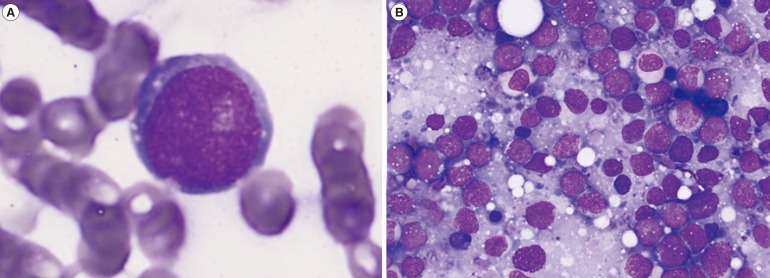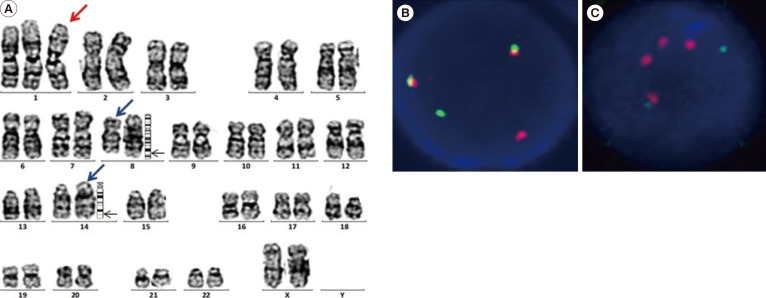Dear Editor
Aberrations of the human chromosome 1 are common in hematologic malignancies such as multiple myeloma, myeloproliferative disorders, and myelodysplastic syndrome, highlighting their significance in carcinogenesis [1]. The isochromosome 1q [i(1)(q10) or i(1q)] is a distinctive structural chromosomal abnormality in hematologic malignancies [2], especially in childhood Burkitt lymphoma/leukemia (BL) [3]. We report the first Korean pediatric BL patient with i(1)(q10) as well as t(8;14)(q24;q32).
A 9-yr-old girl with fever for three days was referred to our hospital for abnormal complete blood count, which revealed the following: hemoglobin, 8.4 g/dL; platelets, 12×109/L; and leukocyte count, 4.46×109/L with 9% lymphoma cells (Fig. 1A). Subsequent physical examinations revealed splenomegaly and several palpable lymph nodes. The patient also showed swelling at both submandibular areas, which developed the day before admission.
Even though the initial bone marrow specimen was dry-tapped and inadequate for accurate differential count, lymphoma cells with bluish cytoplasm and prominent nucleoli were heavily loaded on touch imprint preparation (Fig. 1B). Flow cytometric analysis performed with peripheral blood specimen presented that the lymphoma cells were positive for CD19 and CD10; but negative for CD20, terminal deoxynucleotidyl transferase (TdT), kappa, and lambda surface immunoglobulins. Chromosomal analysis of the bone marrow specimen using standard trypsin-Giemsa banding technique revealed an abnormal karyotype of 47,XX,+i(1)(q10),t(8;14)(q24;q32)[17]/49,idem,+6,+14[6]/46,XX[4] (Fig. 2A). FISH was performed to confirm the abnormality, which indicated the presence of i(1)(q10) (Fig. 2). She was diagnosed as having BL and treated with vincristine and daunorubicin. Although she presented jaundice and liver enzyme elevation that were considered as toxic side effects of the chemotherapy, the patient tolerated the induction and consolidation chemotherapy quite well. Follow-up bone marrow examination and cytogenetic analyses showed no residual lymphoma cells with the 46,XX[20] karyotype. Informed consent was obtained from the patient's parents for the case report.
Among various types of recurrent chromosomal aberrations reported in BL patients, chromosomes 1, 6, 7, 13, 17, and 22 are most frequently affected in up to 70% of the cases [4]. In comparison with other structural rearrangements within the long arm of chromosome 1 [5], i(1)(q10) is unique for genetic dosage gain, which results in a complete triplicate of 1q and distinctive morphologic feature. There were three cases of childhood BL with i(1)(q10) previously classified as ALL FAB L3 type (before the 2008 WHO classification) [67]. Additionally, there were eight case reports of i(1)(q10) in patients with BL [4]. Among these patients, six cases presented abnormal karyotypes, which included i(1)(q10) and t(8;14)(q24;q23) together.
An important question regarding isochromosomes is whether they represent primary or secondary chromosomal change. Isochromosome 1q was observed to be one of the secondary chromosomal changes in BL cell lines [5]. Furthermore, i(1)(q10) in BL was associated with unfavorable therapeutic responses in pediatric patients [48]. Interestingly, our patient showed atypical immature immunophenotype of BL, which was previously suggested to be associated with i(1)(q10) [4]. Apparently, atypical immunophenotype BL has poor prognosis compared with its typical counterpart [9]. High incidence of patients presenting an immunophenotype of immature B-cell arrest among BL with i(1) (q10) patients was recognized, which is consistent with our case. Although impaired immunoglobulin production in tumor cells due to MYC translocation during early B-cell maturation has been proposed as the underlying mechanism, further investigations are required for its complete elucidation.
Centromeric misdivision along the short, rather than the long, axis of a chromosome is one of the possible mechanisms to explain the origin of isochromosomes [10]. Therefore, it is plausible that the centromere of chromosome 1 is unusually susceptible to abnormal division in our patient's lymphoma cells. The genetic consequence of an isochromosome, in addition to the normal chromosome, is acquired isodisomy of 1p and quadrisomy of 1q. As a result, relevant oncogenes on 1q might manifest carcinogenesis, leading to various malignancies including BL [1].
In conclusion, we report the first Korean pediatric BL patient with i(1)(q10). This case provides additional insight into the wide spectrum of chromosomal structural abnormalities. Clinical attention to the appropriate detection of i(1)(q10) by chromosomal analysis and FISH is recommended. Since it is possibly associated with poor clinical outcomes, further studies are required to investigate the implications of i(1)(q10).
References
1. Djordjević V, Dencić-Fekete M, Jovanović J, Drakulić D, Stevanović M, Janković G, et al. Pattern of trisomy 1q in hematological malignancies: a single institution experience. Cancer Genet Cytogenet. 2008; 186:12–18. PMID: 18786437.

2. Hawkins JM, Wood M, Wright F, Secker-Walker LM. Isochromosome 1q in acute monocytic leukemia: a new nonrandom association. Genes Chromosomes Cancer. 1992; 5:181–183. PMID: 1381955.

3. Lai JL, Fenaux P, Zandecki M, Nelken B, Huart JJ, Deminatti M. Cytogenetic studies in 30 patients with Burkitt's lymphoma or L3 acute lymphoblastic leukemia with special reference to additional chromosome abnormalities. Ann Genet. 1989; 32:26–32. PMID: 2751244.
4. Roug AS, Wendtland P, Bendix K, Kjeldsen E. Supernumerary isochromosome 1, idic(1)(p12), leading to tetrasomy 1q in Burkitt lymphoma. Cytogenet Genome Res. 2014; 142:7–13. PMID: 24217199.

5. Maria Murga Penas E, Schilling G, Behrmann P, Klokow M, Vettorazzi E, Bokemeyer C, et al. Comprehensive cytogenetic and molecular cytogenetic analysis of 44 Burkitt lymphoma cell lines: secondary chromosomal changes characterization, karyotypic evolution, and comparison with primary samples. Genes Chromosomes Cancer. 2014; 53:497–515. PMID: 24590883.

6. Wodzinski MA, Watmore AE, Lilleyman JS, Potter AM. Chromosomes in childhood acute lymphoblastic leukaemia: karyotypic patterns in disease subtypes. J Clin Pathol. 1991; 44:48–51. PMID: 1997533.

7. Navid F, Mosijczuk AD, Head DR, Borowitz MJ, Carroll AJ, Brandt JM, et al. Acute lymphoblastic leukemia with the (8;14)(q24;q32) translocation and FAB L3 morphology associated with a B-precursor immunophenotype: the Pediatric Oncology Group experience. Leukemia. 1999; 13:135–141. PMID: 10049049.

8. Havelange V, Ameye G, Théate I, Callet-Bauchu E, Mugneret F, Michaux L, et al. Patterns of genomic aberrations suggest that Burkitt lymphomas with complex karyotype are distinct from other aggressive B-cell lymphomas with MYC rearrangement. Genes Chromosomes Cancer. 2013; 52:81–92. PMID: 23012230.
9. de Souza MT, Mkrtchyan H, Hassan R, Ney-Garcia DR, de Azevedo AM, da Costa ES, et al. Secondary abnormalities involving 1q or 13q and poor outcome in high stage Burkitt leukemia/lymphoma cases with 8q24 rearrangement at diagnosis. Int J Hematol. 2011; 93:232–236. PMID: 21207210.

10. de la Chapelle A. How do human isochromosomes arise? Cancer Genet Cytogenet. 1982; 5:173–179. PMID: 7066878.

Fig. 1
Microscopic morphological examination of the patient's (A) peripheral blood, and (B) bone marrow touch imprint preparation (Wright-Giemsa stain, ×1,000).

Fig. 2
(A) The G-banded karyotype of the patient. Trypsin-Giemsa banded chromosome analysis at 550-band level shows a marker chromosome, which is suspected to be isochromosome 1q (red arrow), as well as the translocation involving 8q24 and 14q32 (blue arrow). (B) Interphase FISH by using Vysis locus-specific identifier (LSI) dual color IGH/c-MYC probe set (Abbott Molecular/Vysis, Downers Grove, IL, USA). Two fusion signals of the 8q24 (c-MYC) and 14q32 (IGH) probes with an additional red and green signal for c-MYC and IGH, respectively indicate translocation involving the two genes. (C) Interphase FISH by using Metasystems LSI dual color CDKN2C/CKS1B probe set (Metasystems, Altlussheim, Germany). Two green and four red signals for 1p32 (CDKN2C) and 1q21 (CKS1B), respectively indicate the presence of isochromosome 1q.





 PDF
PDF ePub
ePub Citation
Citation Print
Print


 XML Download
XML Download